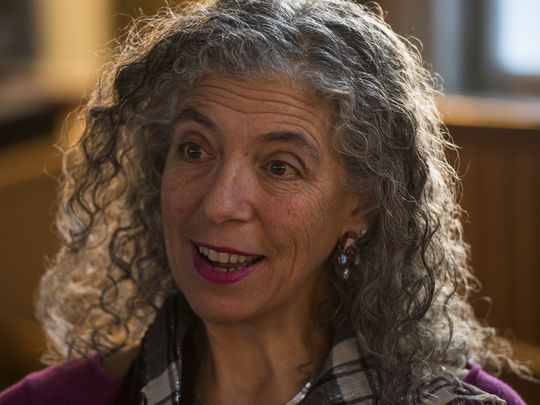Why was the book of Leviticus placed in the center of Torah? You know that there had to be other options. We all feel the shift. Left on the cliff-hanger at the end of Exodus, we spend 8-10 weeks with nary a hint of narrative. It’s as if the Torah lifts us out of time and invites us into a non-linear, existential experience. How might this placement inform our efforts to create change in the world?
Vayikra focuses on the question: how can we keep our ‘fingers in the outlet’ so that we are continually recharged by the electricity of a Holy connection? In mind-numbing details, we learn how to approach, stand before, and depart from the main engine room of all of Creation. From this seeming morass, I want to lift up three points that span the entire book, creating a solid three-legged stool upon which our work rests: ‘pausing’, ‘centering’, and ‘moving stillness to action’.
The first point: Pausing
Rashi comments on the opening word’s ‘vav’ that the text creates two opportunities for pausing. First, Moses is asked to pause in order that he be given a chance to “…contemplate between one passage and the next, and between one subject and the next…” What can we learn from this? Simply that, as leaders, it behooves us to take a moment to pause before rushing headlong into words that will lead to action. First, pause. Then lead.
Secondly, Rashi doesn’t limit this need for pausing to Moses. Rather, he stresses that it is important that the people also pause. He writes, “How much more necessary is it for us ordinary folks to pause, in order to carefully contemplate and understand the materials about to be learned…” Before leaping into the blood and water and spattering and clothes and animals and smoke, we are invited to pause, to stop, linger at the tipping point, between one moment and the next.
The middle point: the Center
Perhaps Vayikra is the center of the scroll to help us suspend the experience of time. Perhaps, we declare, sequence is overrated. We like to teach that there is ‘no before and no after’ in Torah. Vayikra reminds us not to get distracted by the narrative but rather that being in covenant, in connection, in that deep reciprocity which is activated by the cultic ritual, happens outside the constriction of time. And at the core of the covenant is that all of Creation is made in the image of GD, feeding our dedication to heal the broken parts of the world.
The center can also be the fulcrum, the point around which reciprocity see-saws. Think of the Mishkan as the fulcrum of the Israelite people; think of Vayikra as the fulcrum of Torah. That fulcrum is the stable central point around which everything pivots; it is the core value that amplifies our strength and allows us to band together to act, even though each of us is small.
The third point: bringing that pause and pivot into action
The last verse of Vayikra is אֵלֶּה הַמִּצְות אֲשֶׁר צִוָּה ה’ אֶת־מֹשֶׁה אֶל־בְּנֵי יִשְׂרָאֵל בְּהַר סִיני “These are the commandments, which the Lord commanded Moses for the people of Israel in Mount Sinai.” (Lev. 27:34)
The Book of Leviticus is a time for Being without Time; and now there’s the time to get back into the action. In some way, this summation statement recalls and balances the silence of the small aleph that is written in the first word: First there was a silent aleph, a silent pause, then a pivot-point, and finally, the call to literally “swing” into action as we enter again the narrative of Bamidbar. We absorb the wisdom of the sweep of the whole book: before we act, or even AS we act, we stay connected with the covenant and act in GD’s stead.
How does it feel to move forward toward change with what I might call “Vayikra consciousness”? Years ago, I learned from R. Arthur Waskow to translate the word ‘mitzvah’ as a way of making connections. When I ‘tzav’ I am creating a solid triangle by making a connection between myself, the other, and the action itself. I am creating a sense of unity, of wholeness, of healing, that can be absent if I am only doing the mitzvah by rote, in a way that is not an outpouring from the center.
Pause. Pivot. Action. The most difficult part of creating change is the riptide of the minutiae of our tasks. We become so swept up in the narrative of our work, or of the logistics that must be articulated, that we lose sight of the pause, of the silence, of that which gives us leverage. The work of our hands needs to be strengthened by an incessant and compelling struggle to maintain that inner, spirit-eye on our work. This effort can keep us steeped in the nature of reciprocity, of sacred action that our tradition invites us to integrate into our work. We’re not just ‘fixing problems’; Vayikra is the call to repair the tear in the world that is inevitable just by our being human. To pause. To find our core. And to take action. This is a recipe for solid change.
Rabbi Jan Salzman was ordained in 2010 by ALEPH. She is the founder and Rabbi of Ruach haMaqom in Burlington, Vt., and previously served as the Assistant Rabbi and Cantor at the local Conservative synagogue. She was blessed to have been a student of Reb Zalman. Rabbi Jan serves on the Boards of OHALAH and of Living Tree Alliance. Rabbi Jan has lived in Vermont for over 35 years, is married to her “rebbitzmon” Loredo Sola, and has two grown children and 2 grandchildren.

